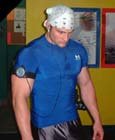Two years it's been since I last stepped foot onto a bodybuilding stage. Two years it's been since I have tested myself against some of the best natural amateur bodybuilders in the world. Two years it's been since I've felt the sensation of hitting a pose and hearing the crowd's response. Now the time has come to return to the stage.
As some of you already know, a rugby injury to my neck (two bulging disks) in October of 2002 kept me from working out my upper body for two months and caused me to lose 35% of my strength on the left side of my upper body. I lost over an inch on most of my measurements on my left side and was told that I might never be as strong as I once was.
Nothing however can match a motivated person's spirit and good friends such as Ted Fletcher (aka Fletch on the boards), James Albury (aka Skip/Abdominator), Anthony Church, Jay Cholewa (Big Red), and Carl DuCharme convinced me that I could come back and be better than ever.
 I began my rehab one year ago at 198 lbs and around 13% bodyfat. I could only incline dumbbell press 80s for 6, shoulder press 70s for 10, curl 45s for 6, and squat 275 lbs for 5. I am happy to report that 11 months later I completed my bulking cycle at 220 lbs and about 13.5% bodyfat. I broke all my old records by incline dumbbell pressing 150s for 4, shoulder pressing 110s for 6, curling 70s for 5, and squatting 405 lbs for 5. So much for never being as strong as I once was.
I began my rehab one year ago at 198 lbs and around 13% bodyfat. I could only incline dumbbell press 80s for 6, shoulder press 70s for 10, curl 45s for 6, and squat 275 lbs for 5. I am happy to report that 11 months later I completed my bulking cycle at 220 lbs and about 13.5% bodyfat. I broke all my old records by incline dumbbell pressing 150s for 4, shoulder pressing 110s for 6, curling 70s for 5, and squatting 405 lbs for 5. So much for never being as strong as I once was.
I have decided to start cutting at approximately 22 weeks out this year and only lose 1-1.5 lbs per week. I want to leave nothing to chance and come in rock hard with striated glutes as a natural competitor. I expect my competition weight to be 185-190 lbs completely shredded. Here are more details of my pre contest preparation…
I will be lifting four times per week and I will perform cardio twice a week for now (10 fifty meter sprints).
Training
- Day 1: Lower body
- Day 2: Upper body
- Day 3: Cardio
- Day 4: Lower body
- Day 5: Upper body
- Day 6: Cardio
- Day 7: Rest
On leg days I will re-feed by lowering protein intake to 250g and raise carb intake to 410g. Since legs are a week point for me, this will hopefully allow me to actually gain a bit of muscle on my legs and allow me to train harder on leg day by providing more carbohydrates for workouts.
Diet
Each day I will consume:
- 300g protein
- 250g carbs
- 60g fat per day
- Protein Sources - Tuna, chicken, cottage cheese, turkey, protein powder, lean beef and eggs.
- Carb Sources - Oatmeal, oat bran cereal, brown rice, whole wheat bread, and low fat popcorn.
- Fat Sources -Fish oil capsules and peanut butter
A sample of my diet for one day is as follows (it may vary as far as food selection goes, but the macronutrient breakdowns will likely remain the same).
Sample Day In Detail
- Meal 1: Turkey on whole wheat bread with lettuce and mustard 35/30/4
- Meal 2: Chicken breast with ½ tablespoon of peanut butter 40/3/10
- Meal 3: Lowfat popcorn, 1 cup oat bran cereal in skim milk and 10 egg whites 40/75/7.5
- Meal 4 (in workout shake): Whey protein and Dextrose with 5g of creatine 35/35/2.5
- Meal 5: Meal 1 + brown rice 35/82/6
- Meal 6: 1 can tuna with mustard, ¼ cup oatmeal, 3 fish oil capsules 35/20/6
- Meal 7: 1 large chicken breast with 3 fish oil caps and ½ tablespoon peanut butter 40/3/13
- Meal 8: 1 can tuna, 2 fish oil caps, ½ tablespoon peanut butter 40/3/11
Breakdown:
- 300g protein
- 251g carbs
- 60g fat
One should take note that this diet is based on nutrient timing. Essentially I vary the amounts of different macronutrients at different times to get the most out of my diet. Perhaps the most important nutrient that I manipulate is my carbohydrate intake at different times of the day. Carbohydrates cause insulin release, which is very muscle sparing very anti-lipolytic. It is therefore important that I construct a diet so that I intersperse long periods of low insulin levels in order to maximize lipolysis, coupled with short periods of high insulin levels to protect muscle when it is at the greatest risk of catabolism.
There are essentially two crucial times during the day when muscle tissue is at the greatest risk of catabolism. The most crucial time is during your workout. As many of you already know, working out is actually catabolic. When one is in a calorie deficit, the catabolic effect of working out is enhanced, as the body will attempt to raise low glucose levels by de-aminating amino acids and converting them to glucose. One of the main hormones that control this action is cortisol.
Unfortunately this is quite catabolic as some of these amino acids may come from muscle tissue.
It is crucial that one consumes carbohydrates before exercise for several reasons:
- Dietary carbohydrates will provide fuel for the anaerobic pathway, and spare muscle tissue from being converted to glucose for fuel.
- Dietary carbohydrates will increase muscle glycogen levels, which will improve performance and decrease fatigue.
I also suggest consume a shake composed of 35g of whey protein along with 35g dextrose during my workout.
The carbohydrates in the shake should account for about consuming this shake provides several benefits:
- Spare muscle glycogen and increase performance
- Spare muscle tissue
- Maintain a constant release of insulin, therefore inhibiting cortisol release
- The continuous ingestion of carbohydrates will ensure that adequate substrate is available for the glycolytic pathway.
I also consume a post workout meal composed of whole food, low GI carbohydrate sources about 30 minutes after finishing the in workout shake. This low GI carbohydrate will help stabilize blood sugar levels.
You see, dextrose causes a very large insulin spike, and actually can cause insulin to be over secreted, when insulin is over secreted, blood sugar levels will drop rapidly as insulin disposes of the glucose into the tissues and one may even begin to experience hypoglycemia (low blood sugar). Low blood sugar may one to experience an increase in hunger. A lower GI carbohydrate and protein meal post workout will help counteract this negative effect by stabilizing blood sugar levels.
The other time of day when I consume a meal containing carbohydrates is upon rising. Waking up is actually a stressful time on the body and in an effort to "ready itself" the body releases several catabolic hormones in order to produce energy for the fasted person. The main two hormones released are cortisol and glucagon both of which can be catabolic to muscle tissue. Consuming a carbohydrate meal will retard the release of these catabolic hormones and spare muscle tissue. It will also make you feel better by providing fuel for your brain to run on.
Stats
After Two Weeks.
Skinfolds:
Three site bodyfat measurement (took 5 at each site and the averages are as follows):
- Average chest skinfold - 11.0 mm
- Average abdominal skinfold - 13.8 mm
- Average quadriceps skinfold - 17.2 mm
- Average bodyfat measurement - 11.80% bodyfat
Muscle Measurements:
- Weight -213 lbs
- Calves - 16 3/8"
- Thighs (at largest part) - 26.75"
- Chest (unflexed) - 46.75"
- Shoulders - 54"
- Arms - 17.5" (they were 18" but a bicep strain has prevented me from training them for 3 weeks)
- Waist - 34"
I will continue to update this log every two weeks. Please send any questions or concerns to me at biolayne@yahoo.com
More Pics:
I am very busy but will do my best to answer your questions in a timely fashion.
Peace,









